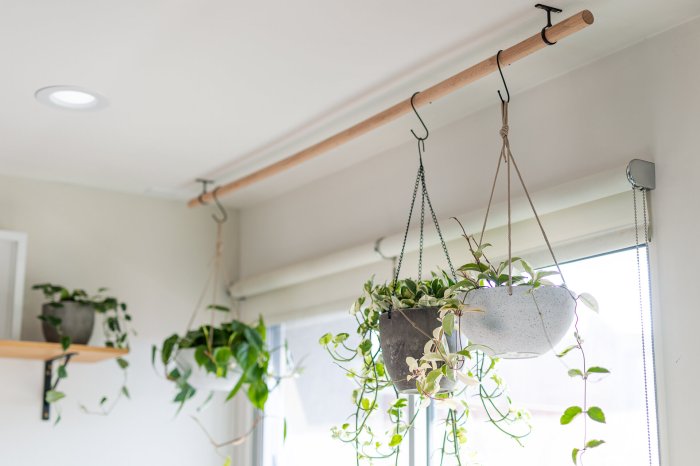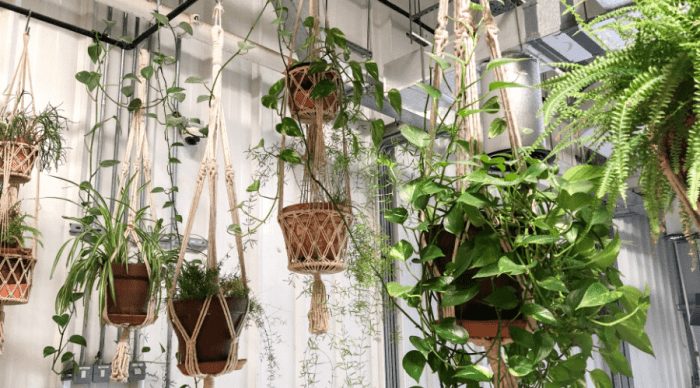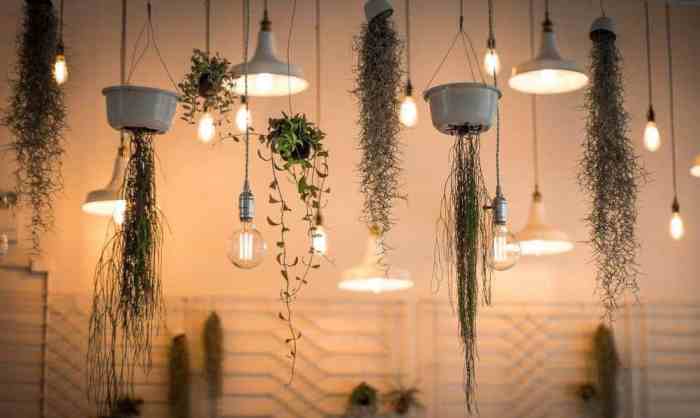10 hanging plants high ceiling, discover the perfect plants to add a touch of greenery to your high-ceilinged space. From trailing vines to cascading blooms, these plants will bring life and beauty to your home.
Hanging plants are a great way to add a touch of greenery to any room, but they can be especially effective in rooms with high ceilings. The height of the ceiling gives the plants plenty of room to grow and spread out, creating a dramatic and eye-catching display.
Plant Varieties for High Ceilings

Hanging plants bring a touch of greenery and life to high-ceilinged spaces, creating a sense of tranquility and freshness. Selecting the right plant species is crucial for success, as they need to tolerate the unique conditions of being suspended high above the ground.
If you’re looking for a way to add some greenery to your home without taking up too much space, hanging plants are a great option. And if you have a high ceiling, you can really make a statement with some trailing plants.
But not all hanging plants are created equal. Some do better in shady conditions than others. If you’re not sure which ones to choose, check out this list of 10 hanging plants good in shade . These plants will thrive even in low-light conditions, so you can enjoy their beauty without having to worry about them getting enough sun.
And with their long, trailing stems, they’re perfect for adding a touch of drama to any room with a high ceiling.
Plants suitable for high ceilings require minimal light, as they may not receive direct sunlight. They should have trailing stems or cascading foliage to create a dramatic effect. Additionally, low-maintenance plants are ideal, as reaching them for watering and care can be challenging.
Ideal Pot Size and Material
The pot size should be proportionate to the plant’s size and growth pattern. Smaller pots are suitable for plants with shallow root systems, while larger pots are better for plants with extensive root growth. Lightweight materials like plastic or hanging baskets are preferred to minimize weight and make it easier to suspend the plants.
Unique Foliage and Trailing Stems
- String of Pearls (Senecio rowleyanus):Known for its trailing stems adorned with plump, pearl-like leaves.
- Spider Plant (Chlorophytum comosum):Produces long, trailing stems with variegated leaves and spiderettes.
- Burro’s Tail (Sedum morganianum):Features fleshy, cylindrical leaves that cascade downwards, resembling a burro’s tail.
Flowering Varieties
- Fuchsia:Hardy plants with pendulous flowers in vibrant colors, such as pink, purple, and red.
- Petunia:Abundant flowering plants with trumpet-shaped blooms in a wide range of colors.
- Calibrachoa:Known for its miniature petunia-like flowers in various shades.
Hanging Techniques and Hardware
Hanging plants from high ceilings can add a touch of greenery and life to any space. However, choosing the right hanging method and hardware is crucial to ensure the safety and well-being of your plants.There are several methods for hanging plants from high ceilings, each with its own advantages and disadvantages.
Ceiling hooks are a simple and affordable option, but they may not be suitable for heavy plants or ceilings made of delicate materials. Chains are a more durable option, but they can be difficult to install and adjust. Macrame hangers add a touch of bohemian style, but they may not be strong enough to support large plants.
Plant stands are a good option for heavy plants or plants that need to be placed in a specific location, but they can be bulky and take up floor space.When choosing a hanging method, it is important to consider the weight of the plant, the height of the ceiling, and the type of ceiling material.
It is also important to use sturdy hardware and to install it securely.
Ceiling Hooks
Ceiling hooks are a simple and affordable way to hang plants from high ceilings. They are available in a variety of sizes and styles, and they can be installed in most types of ceilings. However, ceiling hooks may not be suitable for heavy plants or ceilings made of delicate materials.
Chains
Chains are a more durable option for hanging plants from high ceilings. They are strong enough to support heavy plants, and they can be adjusted to the desired length. However, chains can be difficult to install and adjust, and they may not be aesthetically pleasing to everyone.
Macrame Hangers
Macrame hangers add a touch of bohemian style to any space. They are made from knotted cords, and they can be used to hang plants from high ceilings or walls. However, macrame hangers may not be strong enough to support large plants, and they can be difficult to clean.
Hanging plants are a great way to add some greenery to your home, and they can also help to purify the air. If you have a high ceiling, you can take advantage of the extra space by hanging plants from the ceiling.
There are many different types of hanging plants that can tolerate high ceilings, including ferns, spider plants, and pothos. If you’re looking for a plant that can handle even more light, check out 10 hanging plants high light . Once you’ve chosen your plants, you can hang them from the ceiling using a variety of methods, such as hooks, chains, or macrame hangers.
Hanging plants from the ceiling is a great way to add some life to your home and create a more inviting atmosphere.
Plant Stands
Plant stands are a good option for heavy plants or plants that need to be placed in a specific location. They are available in a variety of sizes and styles, and they can be made from a variety of materials, such as wood, metal, or plastic.
However, plant stands can be bulky and take up floor space.
Light Considerations
In rooms with high ceilings, the distribution of natural light can vary significantly, affecting the growth and well-being of hanging plants. Understanding the different lighting conditions and their impact is crucial for ensuring optimal plant health.
The intensity and duration of sunlight reaching the plants depend on factors such as the orientation of windows, the presence of obstructions, and the time of day. Plants located near windows or skylights may receive ample direct sunlight, while those placed further away may experience indirect or filtered light.
The duration of sunlight exposure also varies depending on the season and the geographical location.
Supplemental Lighting
For plants that require higher light levels, supplemental lighting may be necessary, especially during winter months or in rooms with limited natural light. Artificial lighting options include fluorescent, LED, and high-intensity discharge (HID) lights. The type of light and the intensity required will depend on the specific plant species.
If you’re looking to add some greenery to your home but don’t have a lot of floor space, hanging plants are a great option. They can add a touch of elegance to any room, and they’re perfect for high ceilings.
For more information on how to choose the right hanging plants for your home, check out our 10 hanging plants guide . With so many different varieties to choose from, you’re sure to find the perfect plants to add a touch of life to your home.
Plant Relocation
Relocating plants based on their light requirements can also be an effective strategy. Plants that prefer bright, direct sunlight can be placed near windows, while those that tolerate lower light levels can be moved further away. Regular monitoring of plant growth and health can help determine if relocation is necessary.
Maximizing Sunlight Exposure
To maximize sunlight exposure for hanging plants, choose locations near windows or skylights. Avoid placing plants directly in front of windows, as this can block the light from reaching other plants. Consider using reflective surfaces, such as mirrors or white walls, to bounce light onto the plants.
Adequate Artificial Lighting
When using artificial lighting, ensure that the plants receive sufficient light intensity and duration. Follow the manufacturer’s recommendations for the specific type of light being used. Position the light source close enough to the plants to provide adequate coverage, but not so close as to cause damage.
Watering and Fertilizing

Watering and fertilizing hanging plants at high ceilings can be challenging, but with the right techniques and knowledge, it can be done effectively. Here are some practical methods and guidelines to help you keep your plants healthy and thriving.
Watering Techniques
Reaching hanging plants at high ceilings for watering can be difficult. Here are some practical methods to make it easier:
- Use a watering can with a long spout:This allows you to water plants from a distance without having to climb a ladder.
- Attach a hose to a watering wand:This gives you more reach and control over the water flow.
- Use a pressurized sprayer:This is a quick and easy way to water plants, but be careful not to overwater.
Watering Frequency and Amount, 10 hanging plants high ceiling
The frequency and amount of watering required for hanging plants will vary depending on the plant species, pot size, and environmental conditions. Generally, plants in larger pots will need to be watered less frequently than those in smaller pots. Plants that are exposed to more sunlight will also need to be watered more often.
To determine when your plants need water, check the soil moisture by inserting your finger into the soil. If the soil feels dry to the touch, it’s time to water. Water thoroughly until water drains from the drainage holes in the bottom of the pot.
Fertilizing Hanging Plants
Fertilizing hanging plants is essential for providing them with the nutrients they need to grow and thrive. Use a balanced liquid fertilizer diluted to half strength and apply it every two to four weeks during the growing season.
Maintenance and Troubleshooting

Maintaining hanging plants at high ceilings requires specific techniques and attention to ensure their health and aesthetic appeal. Regular pruning, repotting, and pest control are crucial for their well-being, while accessing these plants safely is paramount.
To access hanging plants at high ceilings, ladders or step stools should be used with caution, ensuring stability and a secure footing. Additionally, long-handled tools, such as pruning shears and watering cans, can extend reach without compromising safety.
Pruning
Regular pruning removes dead or overgrown stems, encourages new growth, and maintains the plant’s shape. For high-ceiling plants, use long-handled pruning shears to access and carefully trim away unwanted foliage.
Repotting
Repotting becomes necessary as plants outgrow their containers. Carefully lower the plant to ground level, repot it in a larger container with fresh potting mix, and gently lift it back to its hanging position.
Pest Control
Hanging plants can attract pests such as aphids, mealybugs, and spider mites. Regular inspection is essential, and if pests are detected, appropriate organic or chemical pest control measures should be applied, taking care to follow label instructions.
Potential Problems and Solutions
- Yellowing Leaves:Overwatering, nutrient deficiency, or insufficient light can cause yellowing leaves. Adjust watering schedule, fertilize regularly, or provide additional light.
- Stunted Growth:Insufficient light, lack of nutrients, or rootbound conditions can lead to stunted growth. Increase light exposure, fertilize, or repot into a larger container.
- Pests:Regular inspection and prompt pest control measures are crucial to prevent pest infestations. Use organic or chemical treatments as needed.
Final Conclusion

Whether you’re looking for a plant to add a touch of elegance to your living room or a statement piece for your entryway, there’s sure to be a hanging plant that’s perfect for you. So take a look at our list of 10 hanging plants high ceiling and find the perfect one to add to your home.
Quick FAQs: 10 Hanging Plants High Ceiling
What are the best hanging plants for high ceilings?
There are many different types of hanging plants that are suitable for high ceilings. Some of the most popular include pothos, philodendron, spider plants, and ferns.
How do I hang plants from high ceilings?
There are a few different ways to hang plants from high ceilings. You can use ceiling hooks, chains, macrame hangers, or plant stands.
How often should I water hanging plants?
The frequency with which you water your hanging plants will depend on the type of plant, the size of the pot, and the humidity of your home. As a general rule, you should water your plants when the soil feels dry to the touch.